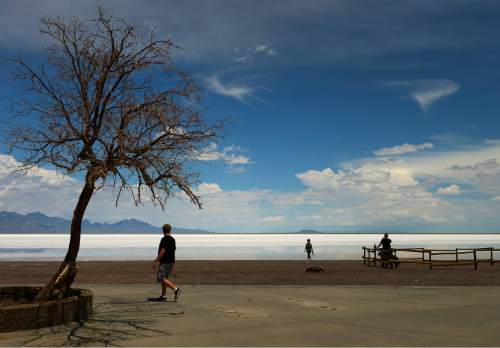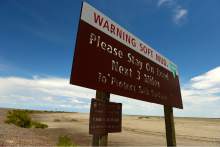This is an archived article that was published on sltrib.com in 2016, and information in the article may be outdated. It is provided only for personal research purposes and may not be reprinted.
The campaign to save the Bonneville Salt Flats entered the legislative fray on Friday with lawmakers lamenting their inability to locally control that situation and other issues on public lands in Utah.
A resolution that "urges the Bureau of Land Management to restore the Bonneville Salt Flats International Speedway to safe high-speed-racing conditions" obtained a unanimously favorable recommendation from the House Natural Resources, Agriculture and Environment Committee. Rep. Steve Handy, R-Layton, the resolution's sponsor, called the condition of the salt flats a "tragedy" and expressed frustration with the BLM's management of the landmark.
"There are things that we cannot do that we would like to do with those lands within our sovereign borders that we cannot effect," he said. "It's a real tragedy, what's happened there. This national resource, that's known around the world, has not been able to be used adequately for several years."
Mike Mower, Gov. Gary Herbert's deputy chief of staff, echoed similar sentiments.
"This is one of the issues we face when we as a state see issues out there with regards to public lands management but we don't control the land," he said. "If something were happening to Delicate Arch, we'd be very concerned. If something happened to Timpanogos Cave or one of our other natural resources, we'd be concerned. Something is happening that we feel is very negative out on our Bonneville Salt Flats."
Land-speed racers who typically use the salt flats to attempt to set new records were unable to host any of their usual events last year due to poor salt conditions.
The racing community believes that mineral mining has extracted so much salt over the years that the flats have begun to thin and recede, revealing the almost quicksand-like mud beneath the halite crust. But the racers have said they don't regard mining operations as the enemy — the companies aren't after the salt, but the minerals contained within it.
The real problem, the racers said, is the BLM's reclamation plan, which doesn't return enough salt to the flats to prevent the landmark's decline.
Rep. Timothy Hawkes, R-Centerville, raised questions about the scientific legitimacy of said decline. He had a letter, he said, from the Utah Geological Survey, indicating that there has been no measurable decline in salt on the salt flats since 1988.
Dennis Sullivan, president of the Utah Salt Flat Racing Association, said the conflict was related to terminology. When the geologists talk about the salt crust of the salt flats, he said, they usually include all the layers beneath, including layers of clay and mud.
When racers talk about the salt, he said, they talk about the upper crust of pure salt. Their own records, which he said go back 50 years, indicate there was once a crust of pure salt as thick as a foot.
"Go out there now and you're lucky to find an inch," he said.
Sullivan said he had gone out on the salt flats with Brenda Bowen, an associate professor of geology and geophysics at the University of Utah who is one of the researchers heading a new initiative to study the state of the Bonneville Salt Flats.
"She went out to show us where there was salt underneath some of the mud that was there," Sullivan said. "After digging down about 18 inches, she conceded that the salt itself is going away."
Bowen, who did not attend the hearing, said in an email that while she did go to the salt flats for a field trip sponsored by the racing community, she did not acknowledge that the salt was disappearing, and actually looked at many areas of the salt flats that were covered with the mineral.
"I have not 'changed my position' on anything," she said. "I am actively doing research on what is a very complex and changing system."
Sullivan said the geologists' position — that the cause of the apparent decline of the salt crust is unknown — didn't make sense.
"It's no longer white; it's brown," he said. "You can't even see the salt. Some geologists say this is a natural occurring event. To me, that's like saying we know that they're taking dirt out of the copper pit, but we don't know if that's what caused the hole."
Other racers testified that, based on personal experience, there has been a decline in the quality and extent of the salt on the salt flats.
"I can remember going out there in 1958 and there was 14.5 miles of track," said Larry Volk, chairman at large of Save the Salt. "There was 4-5 inches of surface salt. I don't care what all the studies say. I've been out there, I've watched it deteriorate — it's basically a mud flat."
Twitter: @EmaPen







